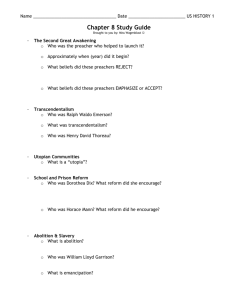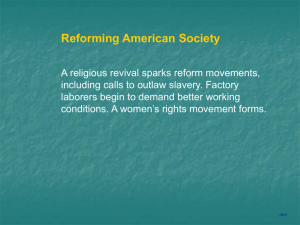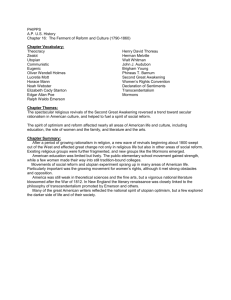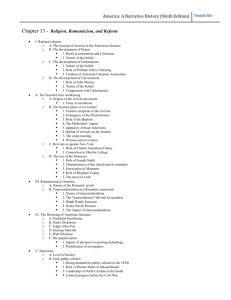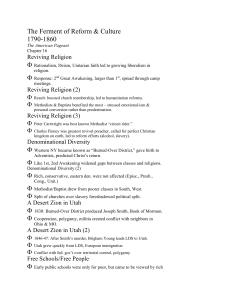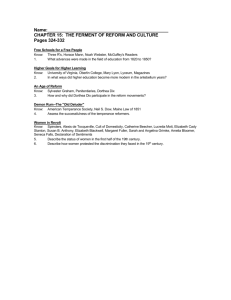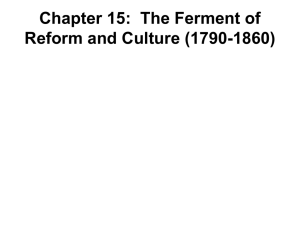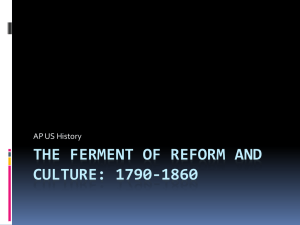File
advertisement
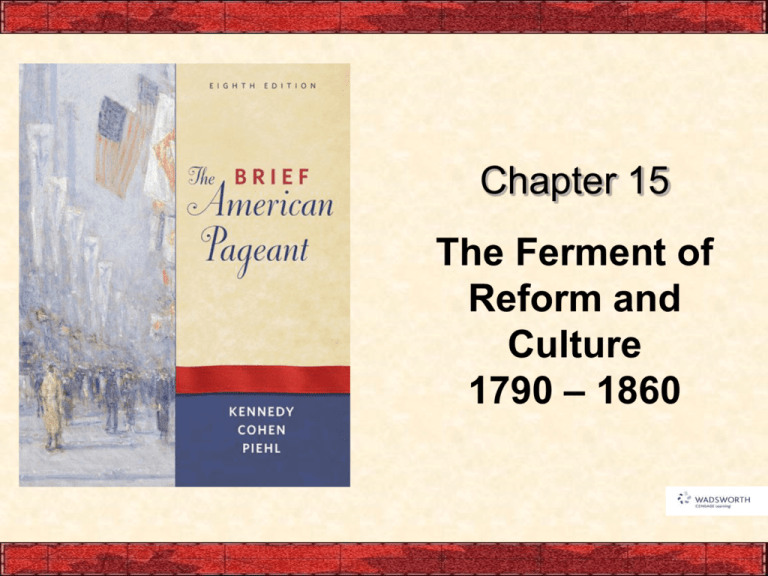
Chapter 15 The Ferment of Reform and Culture 1790 – 1860 p. 222 The Third Revolution A revolution to improve the character of ordinary Americans and make them more upstanding, God-fearing, and literate Some high-minded people were disappointed in the reality of politics Some, mainly women, were left out of politics altogether As America grew, more people poured their energies into religious revivals and reform movements The Third Revolution Cont. Reformers called for: better public schools, rights for women, polygamy, celibacy, rule by prophets, and guidance by spirits Societies were formed against: alcohol, tobacco, profanity, and transit of mail on the Sabbath Overshadowing all reforms was the fight against slavery 1790s- The Second Great Awakening transformed the place of religion in American life and sent out a generation of believers I. Reviving Religion 1850- Church attendance was still regular- ¾ attended out of 23 million Americans, but the Calvinist rigor had been seeping out of the nation’s churches The French Revolution era softened the older orthodoxy Thomas Paine in “Age of Reason” (1794) declared that all churches were set up to “terrorize and enslave mankind.” People were rarely as extreme as Paine, but people like Jefferson and Franklin embraced Deism Relied on reason rather than revelation and rejected the concept of original sin and denied Christ’s divinity, but believed in a Supreme Being I. Reviving Religion Cont. Deism inspired a spinoff of PuritanismUnitarianism Held that God existed in only one person and not in the orthodox Trinity Denied the deity of Jesus, stressed the essential goodness of human nature, the possibility of salvation through good works, and God as a loving Father rather than a stern Creator Appealed mostly to intellectuals whose rationalism and optimism contrasted with Calvinist doctrines of predestination and human depravity I. Reviving Religion Cont. Second Great Awakening started in the South and made its way quickly to the Northeast Was spread by “camp meetings” where as many as 25,000 people would gather for an encampment of several days Boosted church membership and stimulated various humanitarian reforms Moved to engage in missionary work among the Indians, in Hawaii and in Asia Led to prison reform, the temperance cause, the women’s movement, and the crusade to abolish slavery p. 223 I. Reviving Religion Cont. Methodists and Baptists stressed personal conversion, a relatively democratic control of church affairs, and a rousing emotionalism Peter Cartwright- the best known Methodist “circuit riders” (traveling frontier preachers) Spent 50 years traveling from Tennessee to Illinois calling upon sinners to repent Charles Grandison Finney- greatest of the revival preachers who led huge revivals in Rochester and NYC in 1830 and 1831 Wanted a perfect Christian kingdom on earth and denounced slavery and alcohol Served as president of Oberlin College in Ohio that he helped make into a hotbed of revivalist activity and abolitionism I. Reviving Religion Cont. Key feature of the Second Great Awakening was the feminization of religion in terms of both church membership and theology Middle-class women were the first and most enthusiastic proponents for religious revivalism Ambivalence about the expanding market economy made them eager coverts to piety Evangelicals preached a gospel of female spiritual worth and offered women an active role in brining their husbands and families back to God Turned to saving the society Formed a house of charitable organizations and led most of the crusades for reform II. Denominational Diversity Many different denominations had descended from the first settlers of America New England Puritans (“burned over district”) turned into Millerites or Adventists (numbered several hundred thousands) Dampened, but not destroyed by the failed prophecy of their leader, William Miller, who claimed that Christ would return to Earth on October 22, 1844 Second Great Awakening widened the gaps between classes and regions Most prosperous and conservative denominations in the East were little touched by revivalism Wealthier- Episcopalians, Presbyterianism, and Congregationalists Lesser- Methodists, Baptists, & new denominations III. A Desert Zion in Utah 1830- Joseph Smith, a rugged visionary, reported to have received some golden plates from an angel The Book of Mormon and the Church of Jesus Christ of Latter-Day Saints (Mormons) was launched Was a native American product, a new religion, that would spread its influence worldwide Ran into opposition from non-Mormon religions, first in Ohio and then in Missouri and Illinois People were against their voting as a unit and openly drilling their militia for defensive purposes Accusations of polygamy III. A Desert Zion in Utah Cont. Continuing hostility drove the Mormons to desperate measures 1844- Joseph Smith and his brother were murdered and mangled by a mob in Carthage, Illinois and movement seemed near collapse Saved by a remarkable Mormon Moses named Brigham Young Proved to be an aggressive leader, eloquent preacher, and gifted administrator 1846-1847- Young led his oppressed Latter-Day Saints to Utah Made the desert bloom through irrigation By 1848, about 5,000 settlers had arrived p. 225 III. A Desert Zion in Utah Cont. Started a prosperous frontier theocracy and cooperative commonwealth Young married as many as 27 women and begot 56 children Crisis developed when Washington could not control the hierarchy of Brigham Young, who was made territorial governor in 1850 Federal army marched in 1857 against the Mormons, who harassed its lines of supply and rallied to die in their last ditch Quarrel was finally adjusted without serious bloodshed Mormons went against anti-polygamy laws passed by Congress in 1862 and 1882 (delayed their statehood until 1896) IV. Free Schools for Free People Tax-supported schools were rare because they would exist mainly to educate the children of the poor Between 1825 and 1850- the spread of democratic ideas and manhood suffrage for whites won the acceptance for public schools Except in the South Free vote cried for free education One-room, one-teacher “little red schoolhouses” were imperfect shrines of democracy Stayed open only a few months a year, schoolteachers (mainly men) were ill trained, ill tempered, and ill paid- “readin’, ‘ritin’, rithmetic” IV. Free Schools for Free People Cont. Reform was needed Horace Mann- brilliant, idealistic graduate of Brown University who worked as the secretary of the Massachusetts Board of Education Campaigned effectively for more and better schoolhouses, longer school terms, higher pay for teachers, and an expanded curriculumimprovements took place Education remained an expensive luxury for most communities 1860- Only about 100 secondary schools in the nation and nearly 1 million white adult illiterates Blacks legally prohibited to receive any educationSouth IV. Free Schools for Free People Cont. Educational advances were aided by improved textbooks Noah Webster- “The Schoolmaster of the Republic” “Reading lessons”, used to promote nationalism, were used by millions of children in the 19th century Devoted 20 years to his famous dictionary, published in 1828, helped standardized the American language William H. McGuffey- teacher-preacher of rare power Grade-school readers, first published in 1830s, sold 122 million copies in the following decades McGuffey’s Readers- morals, patriotism, idealism p. 227 V. Higher Goals for Higher Learning Second Great Awakening led to small denominational colleges, mainly in the South and West First in the South- North Carolina in 1795 University of Virginia (1819) founded by Jefferson dedicated to freedom from religious or political shackles, modern languages, and the sciences Women’s higher education as frowned upon in the early 19th century- a woman’s place was in the home Believed that too much learning injured the feminine brain, undermined health, and rendered a young lady unfit for marriage Susan B. Anthony’s teachers refused to teach her long division V. Higher Goals for Higher Learning Cont. Women’s schools at the secondary level gained more respectability in the 1820s Emma Willard- establish Troy (New York) Female Seminary Oberlin College opened its doors to women in 1837 (had already shocked people by admitting black students) Mary Lyon- established an outstanding women’s school, Mount Holyoke Seminary in South Hadley, Massachusetts People who craved more learning could do so at private or tax-supported libraries Travel lecturers – Ralph Waldo Emerson V. Higher Goals for Higher Learning Cont. Magazines flourished The North American Review (1815)- the long-lived reader of the intellectual Godey’s Lady’s Book (1830)- survived until 1898 and attained an enormous circulation of 150,000 Devoured devotedly by millions of women, many of whom read the copies of their relatives and friends p. 228 VI. An Age of Reform Reform campaigns of all kinds flourished Second Great Awakening called to battle against earthly evils (old Puritan visions) Perfect society free from cruelty, war, discrimination, intoxicating drink, and ultimatelyslavery Women especially headed these in the struggle for suffrage and provided an escape of the confines of the home and entrance in public affairs The Christianity of these reformers resulted from their desire to reaffirm traditional values as the market economy flourished Blamed problems on bad habits VI. An Age of Reform Cont. Imprisonment for debt continued to be a nightmare 1830s- Hundreds were imprisoned Poorer working classes especially hard hit As laborers won the right to vote, they were eventually abolished Softened the criminal codes Number of capital offenses was reduced Brutal punishments, like whipping and branding, were slowly eliminated Idea that prisons should reform as well as punish “Reformatories”, “penitentiaries”, and “house of corrections” VI. An Age of Reform Cont. Mentally ill still treated cruelly New England teacher-author, Dorothea Dix spent 8 years observing the conditions first hand and petitioned the Massachusetts state legislature in 1843 Resulted in better conditions and the idea that they were not willfully perverse, but mentally ill 1828- American Peace Society was formed as a war on war group that was making promising progress, but setback by the Crimean War in Europe and Civil War in America VII. Demon Rum: The “Old Deluder” Excessive drinking of hard liquor led many to call for reform Was common for most people, including women and clergy Turned weddings and funerals into brawls and embarrassments Fouled the sanctity of the family American Temperance Society was formed in Boston in 1826 Within a few years, a thousand local groups formed Recruited people to sign the temperance pledge and created children’s clubs- “Cold Water Army” VII. Demon Rum: The “Old Deluder” Cont. T.S. Arthur- Ten Nights in a Barroom and What I Saw There (1854) Described a once-happy village ruined by Sam Slade’s tavern Best-seller, second only to Harriet Beecher Stowe’s Uncle Tom’s Cabin Foes of the Demon Drink took two moves of attack: Stiffen the individual’s will to resist alcohol (stressed temperance over elimination) Zealots- called for elimination by legislation VII. Demon Rum: The “Old Deluder” Cont. Neal S. Dowe- Mayor of Portland and employer of labor “The Father of Prohibition”- sponsored the so-called Maine Law of 1851 Hailed as “the law of Heaven Americanized,” it prohibited the manufacture and sale of intoxicating liquor Other states in the North followed suit and by 1857, about a dozen had passed prohibitory laws Prohibitionists made noticeable gains Less drinking among women Probably much less per capita consumption of hard liquor VIII. Women in Revolt 19th Century- It was still a man’s world Women stayed in the home and were subordinate to their husbands Women could not vote Like black slaves, could be beaten by her overlord “with reasonable instrument” Once married, she could not retain title to her property- it passed to her husband Still better than Europe- Alexis de Tocqueville noted that in France, rape was punished only lightly, but in America, it was punishable by death As decades went on, women could be a little more free- some avoided marriage and 10% remained spinsters at the time of the Civil War VIII. Women in Revolt Cont. The market economy was increasingly separating men and women into distinct economic roles Women were thought to be physically and emotionally weak, but artistic and refined They also were believed to be morally in tuned and the keepers of society’s conscience Men were considered strong, but crude, always in danger of slipping into some savage or beastly way of life if not guided by women The home was women’s special sphere. Even reformers like Catherine Beecher celebrated the role of the good homemaker- some felt it a cage VIII. Women in Revolt Cont. Female reformers had a broad range of battles from demanding rights for women, the fight for temperance, and the abolition of slavery Women’s rights movement was led by prominent characters Lucretia Mott- Quaker woman who traveled to London and was not recognized by the anti-slavery convention there in 1840 Elizabeth Cady Stanton- mother of 7 who left “obey” out of her wedding vows and advocated for women’s suffrage Susan B. Anthony- a militant lecturer for women’s rights VIII. Women in Revolt Cont. Other feminists: Dr. Elizabeth Blackwell- A pioneer as the first female graduate of a medical college Margaret Fuller- Edited a transcendentalist journal, The Dial, and took part in the struggle to bring unity and republican government to Italy The Grimke sisters (Sarah and Angelina)champions of anti-slavery Lucy Stone- who kept her maiden name at marriage Amelia Bloomer- revolted against current “street sweeping” female attire and donned a short skirt with Turkish trousers (“bloomers” VIII. Women in Revolt Cont. The feminists met in 1848 in a Women’s Rights Convention at Seneca Falls, New York Stanton read a “Declaration of Sentiments” which like the Declaration of Independence, stressed that “all men and women are created equal.” One of the resolutions called for the ballot for females Launched the women’s rights movement The Crusade for women’s rights was eclipsed by the campaign against slavery Women still could not vote, but were being admitted into colleges gradually Mississippi (1839)- women could own property after marriage IX. Wilderness Utopias Inspired by the utopian spirit of the age, various reformers set up more than 40 communities of a cooperative, “communistic” or “communitarian” nature Robert Owen founded a community (1825) of about 1000 people at New Harmony, Indiana Little harmony (ha-ha) prevailed as it attracted a sprinkling of radicals, work-shy theorists, and outright scoundrels. Brook Farm in Massachusetts (1841) consisted of 200 hundred acres of grudging soil and started with 25 intellectuals committed to transcendentalism Did well until a fire in 1846 took a large new communal building and forced them into debt Inspired Hawthorne’s The Blithedale RomanceI IX. Wilderness Utopias Cont. Oneida Colony (1848)- New York. Practiced free love (“complex marriage”), birth control (through “male continence”), an eugenic selection of parents to produce offspring Flourished for more than 30 years because its artisans made superior steel traps and Oneida Community Plate 1879-1880: Embraced monogamy and abandoned communism Shakers (1770s)- Founded in England by Mother Ann Lee and moved to New York Membership of about 6000 in 1840, but monastic customs prohibiting both marriage and sexual relations drove them to extinction by 1940 X. Artistic Achievements Arts were the slowest to gain momentum Shelters were still built to imitate those in England Public buildings and other important structures imitated the Greeks and Romans (out of place) Greek revival from 1820-1850 Gothic revival in the 1850s Thomas Jefferson was one of the most talented architects of his generation Can be seen through Monticello and the University of Virginia at Charlottesville X. Artistic Achievements Cont. Painting and theater were seen as sinful by the Puritan prejudice, but competent painters still emerged Gilbert Stuart of Rhode Island, was one of the most gifted, produced many portraits of Washington that were idealized and dehumanized Charles Wilson Peale of Maryland, painted some 60 portraits of Washington, who sat for 14 of them John Trumbull, who fought in the Revolutionary War, recaptured its scenes and scores on canvas American painters turned from human subjects to romantic landscapes- Hudson River School Portrait painters received competition from the invention of the French daguerreotype photo X. Artistic Achievements Cont. Music was slowly coming into its own after all non-religious singing was looked down upon by the Puritans Rhythmic and nostalgic “darky” tunes were popular by midcentury Special favorites included the American minstrel shows, featuring white actors with darkened faces Most famous black songs came from Stephen C. Foster Made a valuable contribution to American folk music by capturing the mournful spirit of the slaves in songs like “Old Folks at Home” XI. The Blossoming of National Literature America had produced praiseworthy political essays (The Federalist), political orations by Daniel Webster, and Benjamin Franklin’s Autobiography, but most was imported or plagiarized from Britain The Knickerbocker Group enabled America to boast of a literature to match its magnificent landscapes and had an impressive group of members XI. The Blossoming of National Literature Cont. Washington Iriving- NYC. First American to win international recognition as a literary figure. Published Knickerbocker’s History of New York (1809) with amusing caricatures of the Dutch and Sketchbook (1819-1820) which included DutchAmerican tales like “Rip Van Winkle” and “The Legend of Sleepy Hollow” James Fenimore Cooper- First American novelist to gain world fame The Spy (1821)- tale of the American Revolution Leatherstocking Tales- tales of Natty Bumpo (rifleman) The Last of the Mohicans- Natty and the Indians XI. The Blossoming of National Literature Cont. William Cullen Bryant- New York. Wrote “Thanatopsis,” (1817) one of the first highquality poems produced in the United States Critics couldn’t even believe that it had been written on “this side of the water.” XII. Trumpeters of Transcendentalism Transcendentalism was especially popular near Boston which believed itself “The Athens of America” Resulted in part from a liberalizing of the straitjacket of Puritan theology Owed much to foreign influences, (German romantic philosophers and religions of Asia) Rejected the idea that all knowledge comes to the mind through the senses Trust “transcends” the senses- It cannot be found by observation alone Every person possesses an inner light for the highest truth- in direct touch with God (“Oversoul”) XII. Trumpeters of Transcendentalism Cont. The mystical doctrines defied precise definition, but underlay concrete beliefs Stiff-backed individualism in matters religious and social Hostility to authority and formal institutions of any kind and all conventional wisdom Exaltation of the dignity of the individual, whether black or write- humanitarian reforms Ralph Waldo Emerson- Trained an a Unitarian minister who left the pulpit to reach people through paper and pen “The American Scholar” (1837): an intellectual Declaration of Independence XII. Trumpeters of Transcendentalism Cont. Emerson was not of the highest rank, but more influential as a practical philosopher who reached people through his fresh and vibrant essays Stressed self-reliance, self-improvement, optimism, and freedom His ideals reflected those of an expanding America By the 1850s, he was an outspoken critic of slavery and supported the Union case in the Civil War XII. Trumpeters of Transcendentalism Cont. Henry David Thoreau- poet, mystic, transcendentalist, and nonconformist who was a close associate of Emerson’s. Condemning a government that supported slavery, he refused to pay his Massachusetts poll tax and was jailed for a night Best known for Walden: Our Life in the Woods (1854)- a record of two years he spent living in simple existence in a hut that he built o the edge of Walden Pond, near Concord, Massachusetts Individualist who felt he should reduce his bodily wants to gain time for a pursuit of truth through study and meditiation XII. Trumpeters of Transcendentalism Cont. Walden and On the Duty of Civil Disobedience showed a strong influence in furthering idealistic thought Writings later encouraged Mohandas Gandhi to resist British rule in India and inspired MLK Jr.’s idea of nonviolence during the Civil Rights Movement Walt Whitman Leaves of Grass (1855) gushed genius Highly romantic, emotional, and unconventional Was first a financial failure- only 3 anonymous enthusiastic reviews were ever written about him Won a large following and named Poet Laureate of Democracy p. 237 XII. Trumpeters of Transcendentalism Cont. Louisa May Alcott- Concord. Transcendentalist daughter of a philosopher father, she wrote Little Women and other books to support her family Emily Dickinson- Amherst. Lived as a recluse, but created her own original world through her poetry Used spare language and simple rhyme schemes to explore themes such as nature, love, death, and immortality Refused to publish her works in life, when she died nearly 2000 were found and published I heard a Fly buzz – when I died – The Stillness in the Room Was like the Stillness in the Air – Between the Heaves of Storm – The Eyes around – had wrung them dry – And Breaths were gathering firm For that last Onset – when the King Be witnessed – in the Room – I willed my Keepsakes – Signed away What portions of me be Assignable – and then it was There interposed a Fly – With Blue – uncertain stumbling Buzz – Between the light – and me – And then the Windows failed – and then I could not see to see – XIII. Literary Individualists and Dissenters Edgar Allan Poe was an eccentric genius Orphaned at an early age, cursed with ill health, and married to a child-wife of 13 who fell fatally ill of tuberculosis Suffered hunger, cold, poverty, and debt Was a gifted lyric poet- “The Raven” If he did not invent the detective novel, he set new high standards for it Excelled in the short story, especially the horror genre- fascinated by the ghostly and ghastly Was a contrast of dark sensibility to the optimistic tone of American culture Life cut short when he was found drunk in a Baltimore gutter and died shortly after XIII. Literary Individualists and Dissenters Cont. Two writers showed the Calvinist obsession original sin and the struggle between good and evil Nathaniel Hawthorne- The Scarlet Letter (1850)about a Puritan adulteress and The Marble Faun (1860) about young American artists who witness a mysterious murder in Rome Herman Melville- an orphaned, ill-educated New Yorker who went to sea as a youth and served 18 months on a whaler Moby Dick (1851) is an allegory for good and evil Was ignored at first and Melville worked as a customs inspector and died in obscurity and poverty Wasn’t recognized until the 20th century XIV. Portrayers of the Past American historians were emerging at the same time American writers were George Bancroft- secretary of the navy that helped found the Naval Academy at Annapolis in 1845 Known as the “Father of American History” Published a spirited, super-patriotic history of the United States to 1789 in 6 volumes (1834-1876) William H. Prescott- Published classic accounts of the conquest of Mexico (1843) and Peru (1847) Francis Parkman- Penned a brilliant series of volumes beginning in 1851 that chronicled the struggle between France and Britain in colonial times for mastery of North America XIV. Portrayers of the Past Cont. Early American historians were prominently New Englanders Boston area provided well-stocked libraries and a stimulating literary tradition Writers were mainly abolitionists and had a harsh video of the South The writing of American history suffered for generations from an anti-southern bias
